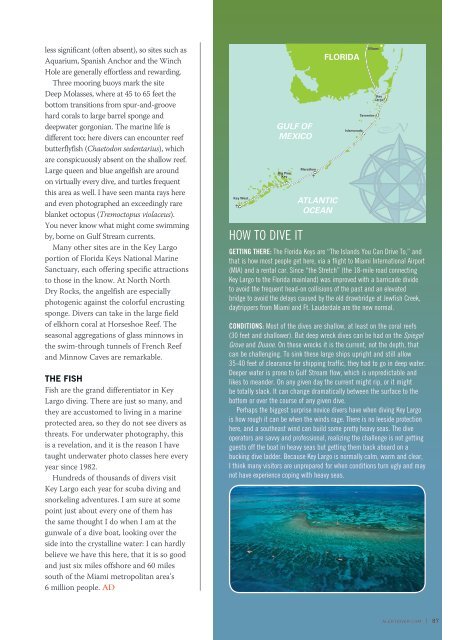AD 2017 Q4
Alert Diver is the dive industry’s leading publication. Featuring DAN’s core content of dive safety, research, education and medical information, each issue is a must-read reference, archived and shared by passionate scuba enthusiasts. In addition, Alert Diver showcases fascinating dive destinations and marine environmental topics through images from the world’s greatest underwater photographers and stories from the most experienced and eloquent dive journalists in the business.
Alert Diver is the dive industry’s leading publication. Featuring DAN’s core content of dive safety, research, education and medical information, each issue is a must-read reference, archived and shared by passionate scuba enthusiasts. In addition, Alert Diver showcases fascinating dive destinations and marine environmental topics through images from the world’s greatest underwater photographers and stories from the most experienced and eloquent dive journalists in the business.
Create successful ePaper yourself
Turn your PDF publications into a flip-book with our unique Google optimized e-Paper software.
less significant (often absent), so sites such as<br />
Aquarium, Spanish Anchor and the Winch<br />
Hole are generally effortless and rewarding.<br />
Three mooring buoys mark the site<br />
Deep Molasses, where at 45 to 65 feet the<br />
bottom transitions from spur-and-groove<br />
hard corals to large barrel sponge and<br />
deepwater gorgonian. The marine life is<br />
different too; here divers can encounter reef<br />
butterflyfish (Chaetodon sedentarius), which<br />
are conspicuously absent on the shallow reef.<br />
Large queen and blue angelfish are around<br />
on virtually every dive, and turtles frequent<br />
this area as well. I have seen manta rays here<br />
and even photographed an exceedingly rare<br />
blanket octopus (Tremoctopus violaceus).<br />
You never know what might come swimming<br />
by, borne on Gulf Stream currents.<br />
Many other sites are in the Key Largo<br />
portion of Florida Keys National Marine<br />
Sanctuary, each offering specific attractions<br />
to those in the know. At North North<br />
Dry Rocks, the angelfish are especially<br />
photogenic against the colorful encrusting<br />
sponge. Divers can take in the large field<br />
of elkhorn coral at Horseshoe Reef. The<br />
seasonal aggregations of glass minnows in<br />
the swim-through tunnels of French Reef<br />
and Minnow Caves are remarkable.<br />
THE FISH<br />
Fish are the grand differentiator in Key<br />
Largo diving. There are just so many, and<br />
they are accustomed to living in a marine<br />
protected area, so they do not see divers as<br />
threats. For underwater photography, this<br />
is a revelation, and it is the reason I have<br />
taught underwater photo classes here every<br />
year since 1982.<br />
Hundreds of thousands of divers visit<br />
Key Largo each year for scuba diving and<br />
snorkeling adventures. I am sure at some<br />
point just about every one of them has<br />
the same thought I do when I am at the<br />
gunwale of a dive boat, looking over the<br />
side into the crystalline water: I can hardly<br />
believe we have this here, that it is so good<br />
and just six miles offshore and 60 miles<br />
south of the Miami metropolitan area’s<br />
6 million people. <strong>AD</strong><br />
Key West<br />
GULF OF<br />
MEXICO<br />
Big Pine<br />
Key<br />
HOW TO DIVE IT<br />
Marathon<br />
ATLANTIC<br />
OCEAN<br />
FLORIDA<br />
Islamorada<br />
Miami<br />
Tavernier<br />
GETTING THERE: The Florida Keys are “The Islands You Can Drive To,” and<br />
that is how most people get here, via a flight to Miami International Airport<br />
(MIA) and a rental car. Since “the Stretch” (the 18-mile road connecting<br />
Key Largo to the Florida mainland) was improved with a barricade divide<br />
to avoid the frequent head-on collisions of the past and an elevated<br />
bridge to avoid the delays caused by the old drawbridge at Jewfish Creek,<br />
daytrippers from Miami and Ft. Lauderdale are the new normal.<br />
CONDITIONS: Most of the dives are shallow, at least on the coral reefs<br />
(30 feet and shallower). But deep wreck dives can be had on the Spiegel<br />
Grove and Duane. On these wrecks it is the current, not the depth, that<br />
can be challenging. To sink these large ships upright and still allow<br />
35-40 feet of clearance for shipping traffic, they had to go in deep water.<br />
Deeper water is prone to Gulf Stream flow, which is unpredictable and<br />
likes to meander. On any given day the current might rip, or it might<br />
be totally slack. It can change dramatically between the surface to the<br />
bottom or over the course of any given dive.<br />
Perhaps the biggest surprise novice divers have when diving Key Largo<br />
is how rough it can be when the winds rage. There is no leeside protection<br />
here, and a southeast wind can build some pretty heavy seas. The dive<br />
operators are savvy and professional, realizing the challenge is not getting<br />
guests off the boat in heavy seas but getting them back aboard on a<br />
bucking dive ladder. Because Key Largo is normally calm, warm and clear,<br />
I think many visitors are unprepared for when conditions turn ugly and may<br />
not have experience coping with heavy seas.<br />
Key<br />
Largo<br />
ALERTDIVER.COM | 87









